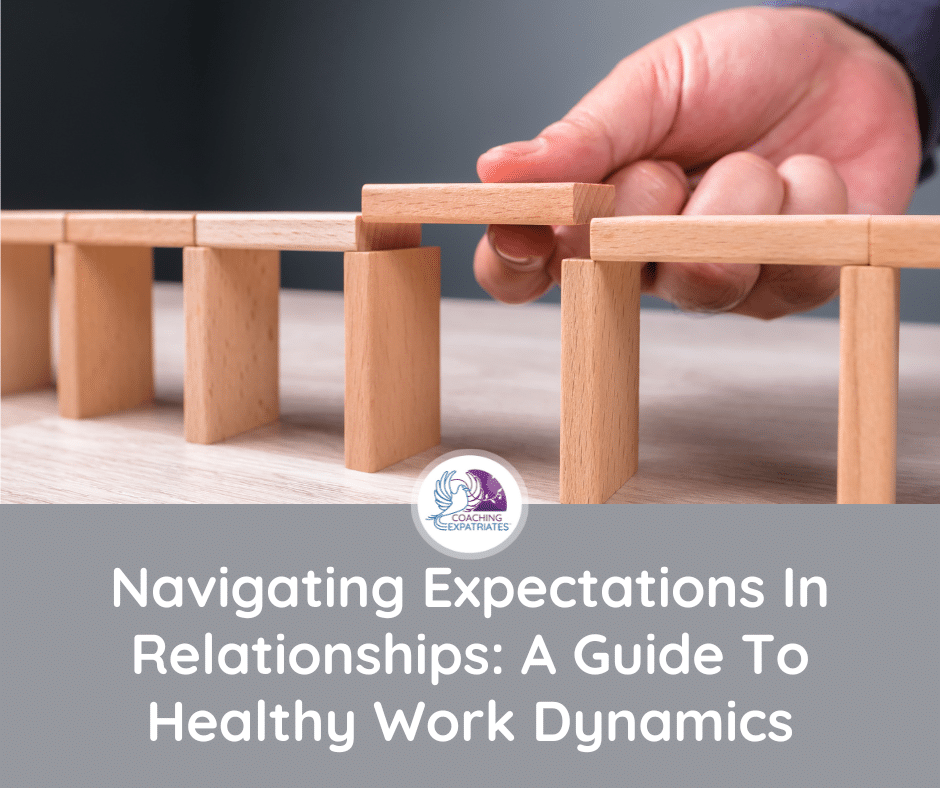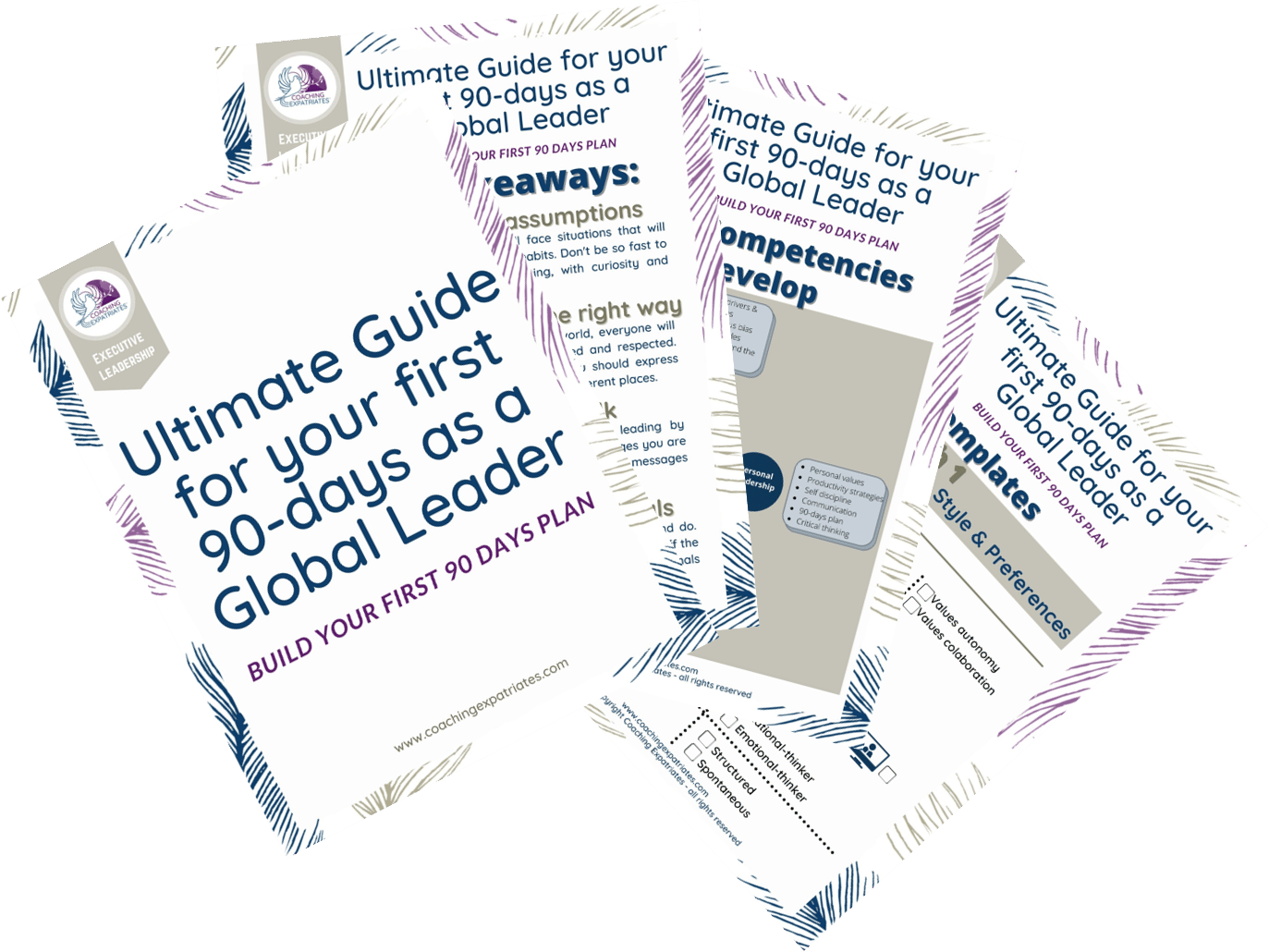In the world of work, relationships are the invisible threads that weave the fabric of every successful global leader’s journey. These relationships extend far beyond mere camaraderie; they define our professional existence and influence our ability to make better business decisions. At their best, they elevate us, boost morale, and propel us towards collective success. Yet, like any human connection, they can also be fraught with challenges, pitfalls, and the occasional misstep.
This blog post will explore the multifaceted landscape of how to manage your expectations for work relationships in big multinational corporations, shedding light on their complexities and intricacies. We’ll explore the lofty expectations we often harbor in these relationships, the delicate balance between supportive and discouraging dynamics, the importance of cultural competence in our interconnected world, and the fine art of gracefully navigating the decision to part ways when the relationship turns toxic.
So, fasten your seatbelts because we’re about to embark on a journey of introspection and discovery into the world of work relationships, with the aim of helping you cultivate healthier, more productive, and fulfilling connections in your professional life. Let’s begin by delving into the first topic: the pitfalls of unrealistic expectations in work relationships.
The Pitfalls Of Unrealistic Expectations In Work Relationships
When it comes to work relationships, expectations play a crucial role. We all have them, whether it’s expecting a colleague to meet a deadline, hoping for recognition from your boss, or anticipating a collaborative and supportive team environment. While healthy expectations can be motivating and productive, the pitfalls of unrealistic or uncommunicated expectations are something we should be aware of.
A. The Danger Of Uncommunicated Expectations And Assumptions
Imagine this scenario: You’ve been working diligently on a project, burning the midnight oil to meet a tight deadline. You assume that your efforts are evident to your manager, and it’s only a matter of time before you receive praise or recognition for your hard work. But weeks go by, and you’re met with silence.
This is a classic example of uncommunicated expectations and the perils of making assumptions. You expected recognition, but did you explicitly communicate that to your manager? Often, we assume that our efforts are self-evident or that others can read our minds. Unfortunately, this is rarely the case.
Uncommunicated expectations can lead to misunderstandings, frustration, and disappointment. Your boss may have had no idea you were seeking recognition because you never expressed that desire. In the absence of clear communication, assumptions fill the void, and those assumptions can be wildly inaccurate.
To avoid this pitfall, it’s crucial to openly communicate your expectations. If you’re working towards a promotion or recognition, have a conversation with your boss about your career goals and the recognition you hope to receive. Don’t assume that others know what you want or need in your work relationships.
B. The Negative Consequences Of Unrealistic Expectations On Relationships
Unrealistic expectations in relationships can be a double-edged sword, harming both you and your colleagues. Let’s say you expect your team to always agree with your ideas without question. While confidence is essential, mismatched expectations of unwavering agreement can stifle creativity and teamwork.
When these unrealistic expectations aren’t met, it can lead to frustration and conflict. You might find yourself resenting your colleagues for not meeting your lofty expectations, while they struggle to keep up with demands that seem impossible.
In the long run, unhealthy expectations erode trust and damage working relationships. Your colleagues may feel overwhelmed and undervalued, leading to disengagement and reduced productivity. Meanwhile, you might feel unsupported and unappreciated, affecting your job satisfaction.
To maintain healthy relationships, it’s crucial to set realistic and reasonable expectations based on open communication and collaboration. Recognize that no one is infallible, and everyone has their strengths and limitations. Embrace diversity of thought and encourage constructive feedback to foster a more harmonious and productive work environment.
While expectations are a natural part of work relationships, we must be cautious of the dangers that uncommunicated or unreasonable expectations can bring. Avoid the assumption trap, and instead, openly communicate your realistic expectations to build stronger, more positive relationships in the workplace.
Supportive Vs. Discouraging Relationships: Striking The Balance
In the world of happy relationships, whether personal or professional, the distinction between supportive and discouraging dynamics can make all the difference in our lives. Let’s dive into what each of these looks like and how to find that critical balance.
A. What Does A Supportive Relationship Look Like?
Supportive relationships are the backbone of our personal and professional lives. Here’s a closer look at what they entail:
1. Supportive of Goals & Growth: In a supportive relationship, your aspirations and ambitions are not just acknowledged but actively encouraged. Your goals become shared objectives, and your partner or colleague genuinely wants to see you succeed.
2. Encouraging – Energizes & Motivates: Supportive individuals provide a source of inspiration. They lift you up when you’re feeling down and give you that extra push when you need it most. Their encouragement acts as a constant motivator.
3. Matching Values: Shared values form the foundation of supportive relationships. When your core beliefs align with those of your work colleagues and boss (or partner and loved ones, for that matter), it creates a sense of unity and mutual understanding. Everything flows better, and communication feels more open and transparent.
4. Non-Judging: Supportive relationships are judgment-free zones that provide room for you to be your authentic self. They allow you to be your true self without fear of criticism or rejection. This authenticity fosters trust and deep connections.
B. What Characteristics Does Discouraging Relationships Have?
On the flip side, discouraging relationships can be detrimental to your well-being. Here are some traits to watch out for:
1. Distractive Or Unsupportive Of Goals & Growth Ambitions: In discouraging relationships, your aspirations may be met with resistance or indifference. Your growth is not a priority for the other person.
2. Discouraging Behaviors. Discouraging behaviors can quickly sap your energy. It can be super draining not only of energy but of motivation to go on or keep up a good work. Negative attitudes, constant criticism or nagging, and pessimism can deplete your energy and enthusiasm.
3. Conflicting Values: Conflicting values that make you feel embarrassed, less worthy, and self-doubt are traits you need to avoid in a relationship. When your values clash too often with those of the other person, it can lead to feelings of inadequacy or embarrassment. You may find yourself doubting your worth or beliefs. In the long run, a relationship with these traits can affect mental health.
4. Judgment and Gaslighting: Gaslighting is a manipulative tactic used to make someone doubt their own reality. In discouraging relationships, judgment and gaslighting can erode your self-esteem and sense of self.
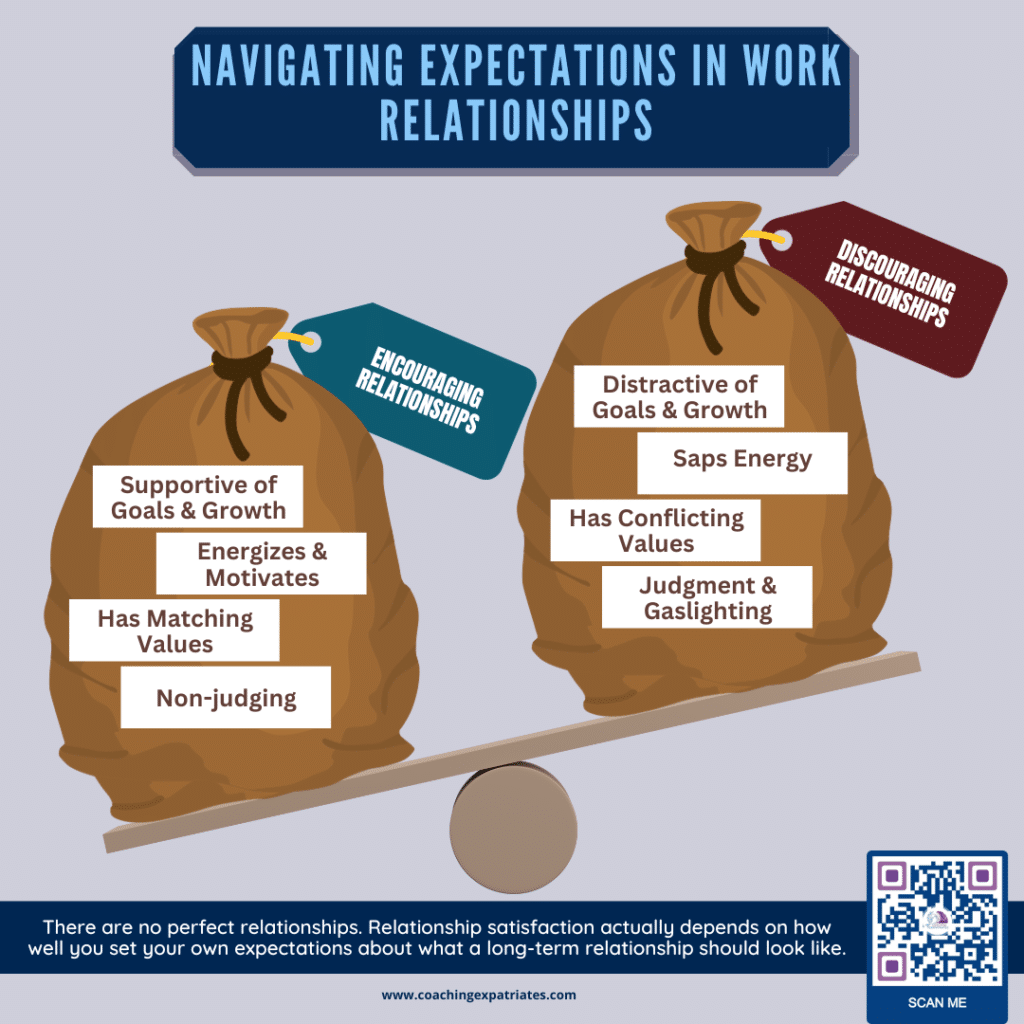
C. The Importance Of Balancing Supportive Vs. Discouraging Relationships
It’s important to recognize that no relationship is perfect, and everyone has their off days or periods of difficulty. Everyone has their fair share of tough times and emotional turmoil. This means relationship satisfaction actually depends on how well you set your own expectations about what a long-term relationship should look like.
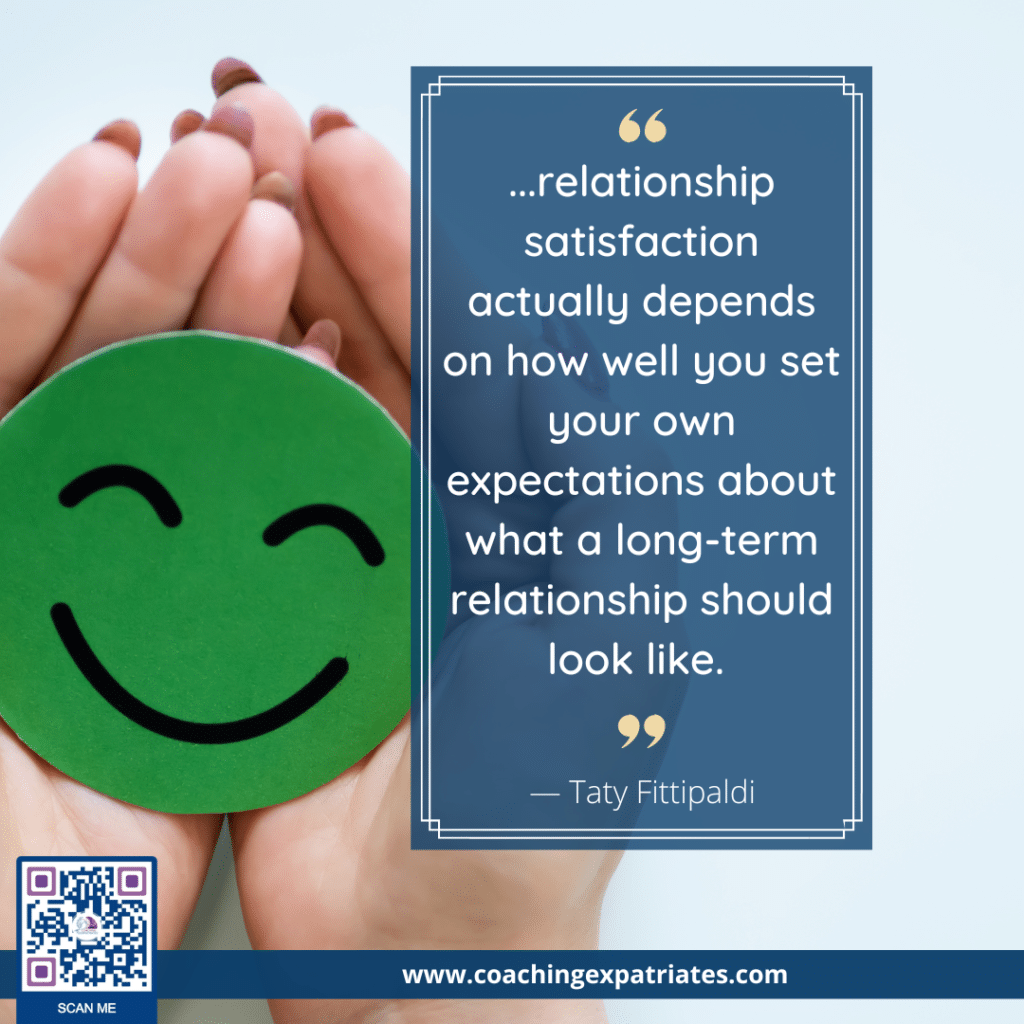
Striving for an 80/20 balance, with 80% of your relationships being supportive and 20% allowing for discouraging moments, can be a realistic and healthy approach that incorporates relationship expectations that are reasonable even through tough times for anyone involved.
In life, challenges and conflicts are inevitable. It’s how we navigate and grow from these experiences that truly matter. The 80/20 balance allows room for human imperfection while ensuring that the majority of the time in your relationships contributes positively to your well-being and growth.
80/20 is my magical number and works for me, but the reality is that everyone has their own boundaries. Maybe 60/40 works best and is tolerable for you. Maybe your personal boundaries only allow 10% of discouraging moments in a relationship. So, my magical number is a suggestion, but you’ll have to find your own balance for true relationship satisfaction. Satisfaction is personal, like panties. You don’t use other people’s panties, right? But they can serve as a reference for you to find your own personal tastes.
The bottom line is that understanding the characteristics of supportive and discouraging relationships can help you make informed choices about the people you surround yourself with. Seek out and nurture supportive relationships that align with your goals and values while recognizing that even discouraging moments in a relationship can offer opportunities for growth and learning. Balancing these dynamics is key to maintaining a healthy and fulfilling social and professional life.
Managing Expectations In Work Relationships: 8 Key Elements
Navigating work relationship expectations with finesse begins with the art of managing expectations. Clear and well-managed expectations lay the foundation for trust, cooperation, and productivity. Let’s dive into a step-by-step guide on how to master this crucial skill:
1. Self-Reflection:
- Know Thyself: Start by understanding your own expectations, biases, and communication style. Self-awareness is the first step in effectively managing expectations with others. I always talk about the Energy Leadership Index Assessment as a great tool to help you discover more about yourself and how you usually show up in life during normal and stressful conditions. I wish everyone on the planet took this assessment at least once in their life. I bet the world would be a little better then.
- Identify Your Needs: Reflect on what you need from your work relationships – be it collaboration, support, or clear communication. Knowing your own needs helps you express them clearly to others. For example, commitments, even the simplest ones, are important to me. If someone breaks one, this immediately erodes my trust in them. I feel that if they can’t keep their word, they are not trustworthy in any aspect of life. So when I see people making commitments to me, I quickly tell them about this aspect of me and let them choose how to reframe or recall the commitment with a soft promise or attempt instead. But you can only do this when you know yourself and identify what you need and what is important to you.
2. Open And Honest Communication:
- Set the Stage: Create an open and safe space for dialogue with your colleagues. Encourage open communication, where everyone feels comfortable sharing their expectations.
- Express Expectations Clearly: When working with others, express your expectations explicitly. Whether it’s project deadlines, roles and responsibilities, or feedback, clarity is key. I recently worked with a client who told me she went to a meeting where she realized there was a noise in expectations after a full hour of frustrating discussions. It’s better to invest 10 minutes of a meeting setting and clearing expectations than lose an entire hour because this was not clearly constructed and communicated at the beginning.
3. Empathy & Active Listening:
- Cultivate Empathy: Develop empathy by putting yourself in your colleagues’ shoes. Understand their perspectives, emotions, and underlying needs, which can help you manage their expectations more effectively. This client I just mentioned was having a frustrating discussion because one of the participants of the meeting was going into too much detail. She never pondered why this gentleman had such a great need to go that deep into the matter, because she didn’t put herself in his shoes at the time. While debriefing the meeting with me and learning from this experience, she realized how full of fear he must have been and how much support he felt he needed. If she addressed that from the beginning, the meeting might have been more productive and less frustrating.
- Pay Attention: Actively listen to what others are saying, both verbally and non-verbally. This helps you gain insights into their expectations and concerns. In the example above, my client did realize his body language was showing clear signs of affliction and anxiety, but she brushed it off and concentrated on what was being said. If you perceive something in people’s body language or any other nonverbal communication, ask them about it. For example, in this case, she could have asked, “I noticed you are afflicted. What’s your real concern? Maybe we can address it and help out.”
- Ask Clarifying Questions: If something isn’t clear, don’t hesitate to ask for clarification. Seek to understand the nuances of your colleagues’ expectations. Asking powerful questions is an art and can help you get further faster. Clarifying things applies not only to expectations but to anything in your communication with the other parties. Including what is not being said but communicated, A.K.A. nonverbal communication.
4. Negotiation And Compromise:
- Find Common Ground: In cases of differing expectations, seek common ground. Negotiation often involves finding solutions that meet both parties’ needs.
- Be Willing to Compromise: Sometimes, compromise is necessary. Be flexible and open to adjusting your expectations when it benefits the team or project.
5. Document Expectations:
- Put It in Writing: When applicable, document expectations in writing. This could be in the form of project plans, emails, or shared documents. It provides a reference point, for healthy relationship expectations and reduces misunderstandings. Putting things in writing is often done after the meeting in an email, but it could also be done during the meeting. I once went to a meeting where, as soon as it began, a person stood up and wrote on the meeting board: 1. Our goal for the meeting, 2. what we should get out of the meeting with, and 3. Who would be affected by our meeting results. As soon as she finished writing that, someone said, “Wait, that’s not my understanding! I didn’t come here for that.” I’ll tell you, that was perfect. We aligned expectations, and everyone got out of the meeting with what they needed.
6. Regular Check-Ins:
- Stay in Touch: Don’t let expectations become static. Regularly check in with your colleagues to ensure that healthy relationship expectations are still aligned as circumstances evolve. Look, things change, people change, circumstances change. So, it makes sense that we need to meet up from time to time to adjust things and expectations if needed.
- Ask for Feedback: Encourage your colleagues to provide feedback on whether your actions meet their expectations. Feedback loops are essential for ongoing alignment.
7. Adaptability And Flexibility:
- Be Adaptable: Recognize that expectations may change due to unforeseen circumstances. Be willing to adapt and find new solutions as needed.
- Flexibility: Show flexibility by adjusting your expectations when the situation warrants it. Sometimes, being understanding and accommodating can strengthen bonds and create more meaningful relationships.
8. Manage Conflicts Constructively:
- Address Conflicts: If expectations clash and lead to conflicts, address them constructively. Focus on finding solutions rather than placing blame.
- Seek Mediation: If necessary, involve a neutral third party or mediator to help resolve conflicts and manage expectations more effectively.
By following these steps, you’ll be well-equipped to manage expectations in your work relationships with greater finesse. Remember, effective expectation management is a continuous process that requires mindfulness, open communication, and a willingness to adapt. When everyone is on the same page, work relationships thrive, leading to greater success and satisfaction in your professional life.
Navigating Healthy Workplace Expectations From Every Angle (a.k.a. Your Cheat Sheet)
Work relationships and environments can significantly impact job satisfaction and overall well-being. Having reasonable and healthy expectations in relationships with the boss, coworkers, and other stakeholders is a key factor in creating a productive and fulfilling work environment. Let’s delve into what these expectations entail:
1. Clear Communication:
- Your Boss: Expect your boss to communicate their expectations, priorities, and goals clearly. Clarity in communication helps you align your efforts with organizational objectives. Believe it or not, but when there is noise in expectations, it could actually be a communication skill problem because managing expectations is a subset of communication skills.
- You: In return, communicate your progress, challenges, and concerns openly and honestly. Honest communication fosters trust and allows for problem-solving.
- Your coworkers: Encourage open communication with your coworkers to foster collaboration and teamwork.
- Your direct reports: Create an environment where your direct reports feel comfortable sharing their thoughts and concerns with you.
2. Constructive Feedback:
- Your Boss: Expect constructive feedback from your boss. Feedback should focus on your performance, areas for improvement, and ways to excel in your role. This guidance is vital for your professional growth.
- You: Be open to receiving feedback and use it as a tool for development. Embrace feedback as an opportunity to learn and enhance your skills.
- Your coworkers: Provide constructive feedback to your coworkers to help them grow professionally.
- Your direct reports: Offer regular feedback to your direct reports to support their development and success.
3. Recognition:
- Your Boss: Expect recognition and appreciation from your boss for your efforts, accomplishments, and contributions. Acknowledgment of your hard work can boost motivation and morale.
- You: Continuously deliver high-quality work, and don’t be shy about sharing your achievements. It helps your boss recognize your contributions more easily.
- Your coworkers: Recognize and appreciate the contributions of your coworkers to strengthen team morale.
- Your direct reports: Acknowledge the achievements and efforts of your direct reports to motivate and inspire them.
4. Helpful Support & Resources:
- Your Boss: It’s reasonable to expect your boss to provide the necessary resources, tools, and training to help you perform your job effectively. This includes access to relevant information, training opportunities, and technology.
- You: Take advantage of the resources provided to excel in your role. Be proactive in seeking out opportunities for skill development.
- Your coworkers: Collaborate with your coworkers to share knowledge and resources to achieve common goals.
- Your direct reports: Ensure your direct reports have the resources and support they need to excel in their roles.
5. Professional Development Opportunities:
- Your Boss: Expect your boss to support your professional growth and career advancement. This could involve opportunities for skill development, mentoring, or career planning discussions.
- You: Take ownership of your professional development by setting clear goals and seeking guidance from your boss on how to achieve them.
- Your coworkers: Collaborate with your coworkers to share knowledge and experiences to enhance each other’s professional growth.
- Your direct reports: Encourage the professional development of your direct reports by providing opportunities for skill-building and mentorship.
6. Fair Treatment:
- Your Boss: Expect equitable treatment in terms of workload, opportunities, and rewards. Your boss should treat all team members fairly, without favoritism or discrimination.
- You: Advocate for fairness in your workplace and raise concerns if you believe there’s inequity. Be a team player who supports your coworkers and direct reports.
- Your coworkers: Treat your coworkers with mutual respect and fairness, promoting a harmonious work environment.
- Your direct reports: Ensure you’re treating your direct reports equitably and providing them with equal opportunities for growth and recognition.
7. Transparency:
- Your Boss: Expect transparency regarding company decisions, changes, and future plans that may affect your work or the team. Being informed about the organization’s direction can help you make informed decisions about your career.
- You: Stay informed about your company’s goals and direction. Transparency works both ways, and you should also communicate your career aspirations and concerns transparently.
- Your coworkers: Foster transparency within your team by sharing information and updates that may impact their work.
- Your direct reports: Keep your direct reports informed about team and organizational changes that may affect their roles or career paths.
8. Work-Life Balance:
- Your Boss: Expect your boss to respect your work-life balance and not consistently demand excessive overtime or work during vacations. Balance and well-being are important for long-term productivity.
- You: Set boundaries and communicate them clearly to ensure a healthy work-life balance. Prioritize self-care to maintain your well-being. Also, make sure to give attention to your romantic relationships with quality time, as when a sense of connection is lacking, this can be a source of conflict that could affect your perception of work-life balance.
- Your coworkers: Support your coworkers in maintaining their work-life balance by respecting their quality time and commitments outside of work.
- Your direct reports: Encourage your direct reports to maintain a healthy work-life balance to enhance their overall well-being and productivity.
9. Timely Conflict Resolution:
- Your Boss: Expect your boss to handle conflicts and issues professionally and constructively. A healthy boss should provide guidance and support when team conflicts arise.
- You: Approach conflicts with a solution-oriented mindset. Communicate concerns calmly and work collaboratively to find resolutions. Honest conversations can sometimes make wonders when conflicts arise.
- Your coworkers: Encourage open and respectful communication among coworkers to prevent conflicts from escalating. Collaborate on resolving issues to maintain a harmonious work environment.
- Your direct reports: Create an environment where your direct reports feel comfortable discussing conflicts and provide guidance to help them resolve issues effectively.
10. Trust & Respect:
- Your Boss: Mutual trust and respect are fundamental in any work relationship. Your boss should trust your abilities and respect your boundaries and decisions.
- You: Build trust through consistent performance and open communication. Show a level of respect for your boss’s authority while also valuing your own contributions. When people think you don’t have respect for them, even if you do, this perception gap can be a source of conflict, and impact the sense of stability in the work relationship.
- Your coworkers: Foster a culture of trust and respect within your team by valuing each other’s opinions and contributions.
- Your direct reports: Demonstrate trust in your direct reports’ abilities and respect their unique perspectives and contributions.
11. Appropriate Boundaries:
- Your Boss: Expect that your boss will maintain professional boundaries and avoid intruding into your personal life or making unreasonable demands outside of work hours.
- You: Respect your boss’s boundaries as well and maintain professionalism in all interactions.
- Your coworkers: Maintain professional boundaries with your coworkers, respecting their personal space and time.
- Your direct reports: Set clear boundaries with your direct reports to ensure a healthy balance between work and personal life.
12. Clear Performance Expectations:
- Your Boss: Expect clear and reasonable performance expectations from your boss. Knowing what is expected of you is crucial for setting goals and measuring progress in your role.
- You: Seek clarification when expectations in relationships or in a task are unclear and ensure you’re aligned with your boss’s goals and objectives.
- Your coworkers: Encourage transparent performance expectations among coworkers to facilitate collaboration and accountability.
- Your direct reports: Clearly communicate performance expectations to your direct reports and provide guidance on how they can excel in their roles.
13. Fair Compensation:
- Your Boss: Expect to receive fair and competitive compensation for your skills, experience, and contributions. This includes regular reviews and potential salary adjustments.
- You: Advocate for fair compensation by staying informed about industry standards and making a case for your contributions during salary discussions.
- Your coworkers: Support fair compensation practices within your organization by advocating for equal pay for equal work.
- Your direct reports: Ensure your direct reports are compensated fairly and are aware of the criteria for performance-based rewards and salary adjustments.
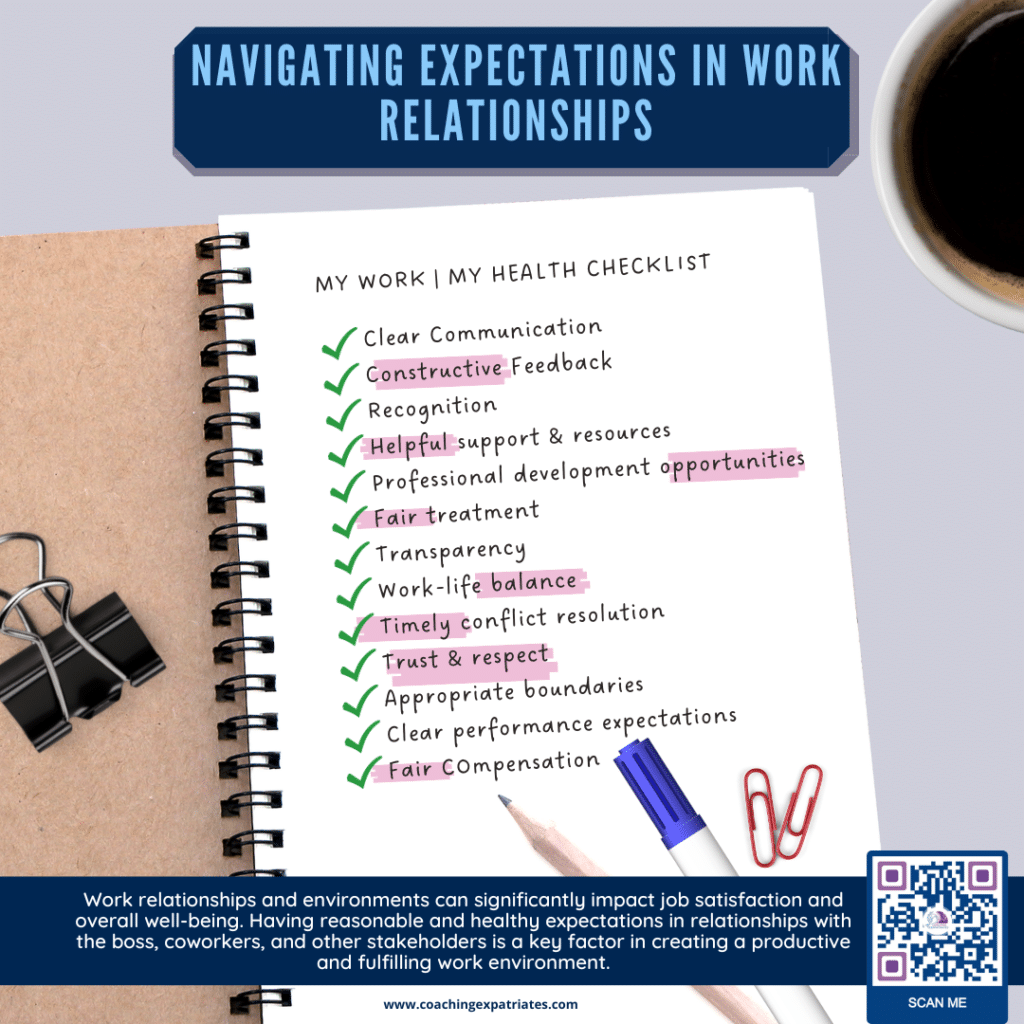
Incorporating these expectations into your work relationships with your boss, coworkers, and direct reports can lead to a more positive and productive work environment for everyone involved. It promotes a culture of collaboration, growth, and respect, ultimately contributing to the success of both individuals and the organization as a whole.
Cultural Competence: The Key To Navigating Diverse Work Relationships
In today’s globalized workforce, it’s not enough to excel in your field; you must also excel in understanding and navigating the intricate tapestry of cultures that intermingle within your workplace. This is where the concept of cultural competence becomes a game-changer, especially when it comes to managing work expectations and overall relationship expectations with your international coworkers.
Understanding Cultural Competence:
Cultural competence isn’t just about recognizing different cultural norms or appreciating international cuisines. It’s a comprehensive set of skills and knowledge that allows you to effectively interact with people from diverse backgrounds. Some of these skills and knowledge come in the form of models that try to help executives quickly assess people and contexts to better interact with multicultural teams. Some of these models are The Culture Map, The Lewis Model, and the High & Low Context Communication models. In the context of work relationships, cultural competence is about grasping how cultural differences can influence expectations and behaviors, communication styles, and interpersonal dynamics.
Why Cultural Competence Matters In This Context:
- Respect and Inclusivity: Cultural competence fosters an environment of respect and inclusivity. When you understand and appreciate different cultural perspectives, you’re more likely to treat your colleagues, superiors, and subordinates with the respect they deserve.
- Effective Communication: Effective communication is the cornerstone of any successful relationship, and cultural competence is essential for effective cross-cultural communication. It helps you avoid misunderstandings, misinterpretations, and unintentional offenses.
- Navigating Expectations: Reasonable expectations in a relationship can vary greatly across cultures. What’s considered assertive in one culture may be seen as aggressive in another. By being culturally competent, you can better navigate these nuances and bridge the gap between expectations.
- Conflict Resolution: Cultural competence is instrumental in resolving conflicts that may arise due to differing or mismatched expectations or communication styles. It allows you to approach conflicts with sensitivity and a willingness to find a common or middle ground.
How To Cultivate Cultural Competence:
Cultivating cultural competence is an ongoing process that requires self-awareness, education, and practice. Here are some steps to get started:
- Self-Reflection: Begin by examining your own cultural biases and beliefs. Understanding your own cultural background is the first step in becoming culturally competent.
- Education: Invest time in learning about different cultures, their customs, values, and communication styles. Reading books, taking courses, and engaging in cultural immersion experiences can be invaluable.
- Active Listening: When interacting with colleagues from different cultures, practice active listening. Pay attention to non-verbal cues, ask clarifying questions, and seek to understand their perspective.
- Openness to Feedback: Be open to feedback and correction. If someone points out a cultural misunderstanding or offense you’ve made, view it as an opportunity to learn and grow.
- Seek Cultural Advisors: If possible, seek out mentors or advisors from different cultural backgrounds who can provide guidance and insights.
In today’s diverse and interconnected workplace, cultural competence isn’t just a desirable skill; it’s a necessity. By embracing cultural competence, you’ll not only navigate work expectations and relationships more effectively but also contribute to a more inclusive and harmonious work environment for all.
Knowing When to Part Ways: Leaving an Unhealthy Work Relationship with Finesse
In the world of work, relationships are not limited to colleagues or bosses; they extend to the very organization you call your workplace. Just like any relationship, there comes a time when you might need to evaluate its health and consider parting ways. But how do you know when it’s the right time to break free, and how can you do it with finesse? Well, that happens in 3 steps. Recognizing, timing and leaving. Let’s dive in to see what I mean.
STEP 1 | Recognizing The Signs Of An Unhealthy Work Relationship:
Before you can make a graceful exit, it’s crucial to recognize the telltale signs of an unhealthy work relationship. These signs can manifest in various ways:
- Constant Stress and Burnout: If you find yourself perpetually stressed, overwhelmed, or experiencing burnout, it may be a sign that your work environment is taking a toll on your well-being.
- Lack of Growth and Development: A stagnant career with no opportunities for growth or professional development can be disheartening and detrimental to your long-term goals.
- Toxic Culture: A workplace with a toxic culture marked by gossip, backstabbing, or bullying can negatively affect your mental and emotional health.
- Misalignment with Values: When your organization’s values clash with your personal or ethical beliefs, it can create a constant state of discomfort and conflict.
- Physical and Mental Health Deterioration: Persistent health issues, sleep problems, or anxiety related to your job may indicate a deeper problem.
- Consistent Disregard for Work-Life Balance: A chronic imbalance between work and personal life can lead to strained relationships, burnout, and a diminished quality of life.
STEP 2 | Timing the Exit: When Is It Right?
Determining when it’s the right time to leave an unhealthy work relationship can be a complex decision, but a few key factors can help guide you:
- Multiple Attempts at Resolution: If you’ve made sincere efforts to address issues, communicate with your superiors, and seek solutions, yet problems persist, it may be time to consider moving on.
- Impact on Mental and Physical Health: Your well-being should always be a priority. If your job is negatively affecting your health, it’s a clear signal that change is necessary.
- Stagnation and Lack of Fulfillment: If you’ve hit a career plateau with no prospects for growth or job satisfaction, it’s worth exploring opportunities that align better with your aspirations.
- Strong Alignment with New Opportunities: Sometimes, a fantastic new opportunity may present itself that aligns perfectly with your goals and values, making it the right time to make the transition.
STEP 3 | Departing With Finesse:
Once you’ve decided to leave an unhealthy work relationship, how you do it matters. Here are some tips for a graceful departure:
- Plan and Prepare: Start by organizing your transition. Ensure that your work responsibilities are handed over smoothly to minimize disruption.
- Communicate Professionally: Inform your supervisor and HR of your decision in a respectful and professional manner. Express gratitude for your time with the company.
- Give Notice: Whenever possible, provide a reasonable notice period to allow for a seamless transition. This shows your commitment to leaving on good terms.
- Stay Positive: Avoid burning bridges. Maintain a positive attitude, even if you’re leaving due to negative circumstances.
- Network and Connect: Continue building professional relationships within your industry. You never know when your paths may cross again.
- Reflect and Learn: Use the experience as an opportunity for personal growth and learning. Identify what you can take away from the situation to avoid similar challenges in the future.
- Embrace the New Beginning: Focus on the exciting possibilities ahead and the chance to find a healthier, more fulfilling work relationship.
Listen, I want to stress out that leaving an unhealthy work relationship is not a sign of weakness; it’s a courageous step toward a happier, more prosperous future. Nobody deserves a miserable day, and when we work unhappily, that’s what we get every single day. By recognizing the signs, timing your exit thoughtfully, and departing with finesse, you can embark on a new chapter with confidence and optimism. And if you need support for your transition, you can always hire a good executive coach to help you through the entire process. Your career and well-being are worth it.
A word of caution: not always you’ll have a company and or a boss who will let you part ways with finesse. Certain people with very limited emotional control and self-regulation will make a fuss, make you feel miserable, or even hurt your reputation by spreading bad things about you. Whatever the threat is, once you decide the best thing is to leave, leave with grace, regardless of what people think or do. People’s negative reactions to your decisions tell more about them (and their work ethics) than about you. Don’t be fazed by this. Chin up and do what’s best for you.
Books Worth Reading When Dealing With Work Expectations
As corporate executives, we face many different challenges with our ongoing relationship with our stakeholders. Here are some valuable books that support the idea of managing expectations through constructive conversations and emotional regulation.
Crucial Conversations: Tools for Talking When Stakes Are High
by Al Switzler, Joseph Grenny, and Ron McMillan | Date of Release: 2002
This book offers valuable insights on how to handle high-stakes conversations effectively, which is crucial for managing expectations and resolving conflicts in the workplace. It provides practical strategies for improving communication, building trust, and achieving better results when the pressure is on.
Why it’s worth reading: Corporate executives often need to navigate difficult conversations, and this book equips them with the tools to do so successfully. It helps leaders foster a culture of open dialogue and constructive feedback within their organizations.
Expectation Hangover: Overcoming Disappointment in Work, Love, and Life
by Christine Hassler | Date of Release: 2014
Christine Hassler explores how unmet expectations can lead to disappointment and offers strategies for managing and reframing these situations. While not exclusively focused on the corporate world, the principles discussed in the book can be applied to work relationships and career expectations.
Why it’s worth reading: Executives can benefit from understanding how to cope with disappointment and adapt to unexpected challenges in their professional lives. This book provides insights into resilience and personal growth.
The Five Dysfunctions of a Team: A Leadership Fable
by Patrick Lencioni | Date of Release: 2002
Through a fictional narrative, Patrick Lencioni identifies common dysfunctions that can undermine team performance, including issues related to expectations. He provides a framework for addressing these dysfunctions and creating a cohesive and high-performing team.
Why it’s worth reading: Corporate executives often lead teams, and this book helps them understand and address common pitfalls in team dynamics, including unspoken expectations that can lead to conflict.
Difficult Conversations: How to Discuss What Matters Most
by Douglas Stone, Bruce Patton, and Sheila Heen | Date of Release: 1999
This book offers practical advice on handling difficult conversations with finesse. It provides a framework for addressing concerns, clarifying expectations, and finding common ground in various interpersonal and professional situations.
Why it’s worth reading: Executives can enhance their communication skills and conflict resolution abilities by learning how to approach challenging conversations constructively. This book provides actionable strategies for achieving better outcomes.
Radical Candor: Be a Kick-Ass Boss Without Losing Your Humanity
by Kim Scott | Date of Release: 2017
Kim Scott introduces the concept of radical candor, which involves a combination of caring personally and challenging directly when giving feedback. The book provides guidance on building strong working relationships and fostering a culture of open and honest communication.
Why it’s worth reading: For corporate executives, providing and receiving feedback is a critical aspect of managing expectations and performance. This book offers a fresh perspective on how to do so effectively while maintaining positive relationships.
Final Thoughts
As we conclude this exploration of work relationships, it’s clear that nurturing and managing them is an art as well as a science. The journey from setting realistic expectations to fostering a culture of cultural competence is a nuanced path, but one that is profoundly rewarding.
Remember that no relationship is ever static. They ebb and flow, evolve, and sometimes, they reach their natural conclusion. That’s perfectly okay. By embracing the wisdom shared in this blog post, you’re equipped not only to navigate the complexities of work relationships but also to cultivate healthier, more rewarding connections that uplift both you and your colleagues. Whether you’re setting clear expectations, balancing support and discouragement, honing your cultural competence, or gracefully parting ways when necessary, your efforts contribute to a more harmonious, productive, and fulfilling professional life. So, embrace these insights, put them into practice, and watch your work relationships flourish.
If you are looking for a leadership development partner and consultant to help you build rules of engagement with your team, set clear expectations and goals, and implement some of the ideas from this post, you can hire me as your executive and development coach. Have a Free Strategy Call with me. We will go over your specific situation, and devise together a methodical but fun way to turn your tables on this matter. We will implement practices and ideas together during our coaching journey so you can feel more confident and poised.
If you are interested in developing specific global leadership skills, personally or team-wise, check out our online Global Executive Leadership program. We go over all The Global Leadership Pillars™ during 9 online modules, specially meant for global leadership development. It’s a unique leadership training methodology that will change the way you think, relate, and strategize as a global leader. You can also subscribe to our global leadership podcast, The Leadership Nest.
If you enjoyed this post, consider subscribing to our newsletter using the form below. We focus on providing good content to global leaders and executives who want to make impactful business decisions and be more inclusive and influential. We know your inbox is sacred, so we email just once per week, and we never sell, rent, or do anything funky with your information. Trust is the basis of Global Leadership, and we fully honor it.

